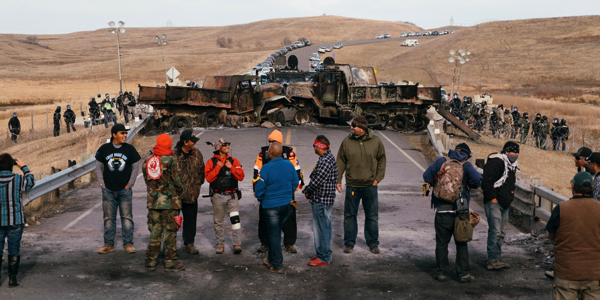
At least seven journalists have been arrested while covering the North Dakota pipeline protests. The Army Corps of Engineers has also set up a “free speech zone” further away from the pipeline than the current protests. The “free speech zone” is an area where the protests would be allowed to protest.
PAT BOYLE, A Denver-based journalist, was shot in the abdomen last Sunday by a rubber bullet as he reported from North Dakota on a clash between demonstrators and police that would end with 26 protesters sent to hospitals and 300 requiring other medical treatment. One woman was severely injured and underwent emergency surgery on her arm after officers unleashed “less than lethal” weapons, including rubber bullets, icy cold water, and, reportedly, concussion grenades on the crowd. Police were reacting to an attempt by Dakota Access pipeline opponents to tow away burned vehicles that officers had secured in place to act as a highway blockade, preventing access to pipeline construction sites down the road. The rubber bullet that hit Boyle tore right through his press pass, leaving a jagged hole through the words “Unicorn Riot,” his news organization’s name.

Reporter Pat Boyle’s press pass after he was shot in the abdomen with a rubber bullet.
Source: Twitter
This wasn’t Unicorn Riot’s first run-in with police while covering the pipeline conflict, nor was it the media collective’s most serious. Reporters for Unicorn Riot have been arrested three times in North Dakota and twice while covering Dakota Access pipeline protests in Iowa. In North Dakota, at least seven journalists in total have been arrested while covering the clashes, according to a count by the Bismarck Tribune. Others have been stung by tear gas, pepper spray, or rubber bullets.
The arrests of journalists and filmmakers covering the front lines of the Dakota Access pipeline fight highlight the limits of press protections and the central role of police, prosecutor, and court discretion in deciding whether or not members of the press should face legal consequences when covering protests. The arrests and violent crowd suppression tactics also reflect the refusal of police to discriminate between peaceful protesters, aggressive agitators, and journalists.
Unicorn Riot was one of the few media outlets that showed up on April 1, when members of the Standing Rock Sioux tribe arrived on horseback to set up a camp called Sacred Stone as a base for prayer and protest against the planned Dakota Access Pipeline, which if completed will transport half a million barrels of oil per day from the Bakken shale region of North Dakota to a hub in Illinois. And the media collective has remained a presence as the standoff reaches into the winter months with few signs of abating.
Via The Intercept